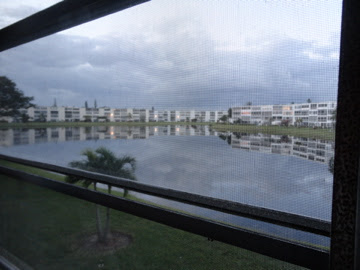Retirement communities are, by design, fairly sterile places. Much of south Florida is covered in huge gated spreads of nearly identical buildings with neatly trimmed lawns leading down to pleasingly curving shallow canals so that every apartment can have water views. It is uniform, controlled, boring. But all those networks of shallow canals catching lawn fertilizer and Florida sun provide habitat and highways for rapidly growing aquatic plants, which feed aquatic invertebrates and fish. With relatively few retirement community residents catching their own fish, this leaves the fish to grow as big as want.
Or at least it used to. When I was a kid visiting my grandparents in Century Village, I rarely saw any wildlife around the wide place in the canal (referred to as a lagoon because it increases resale values) behind their apartment.
When I was a teenager and my grandmother was widowed, the lawn by the water was occupied by a flock of Muscovi Ducks (plant eaters), Cattle Egrets (which eat mostly insects picked from lawns) and the very occasional Great Blue Heron, which eat only small to medium fish. My aunt inherited the same apartment, and my wife and I brought our baby daughter to visit her this winter. Our first morning there, jetlag woke us early. Standing by the lagoon was a flock of Wood Storks. Walking past them in the water's edge was a flock of White Ibis, trailed by a Tricolor Heron.
On the far bank an Anhinga spread its black wings to the sun. A few feet away lay a huge dead fish, heavily built and probably 80cm long, partly eaten by something. What could kill a fish that big, drag it up on the bank and eat only part of it? Walking the banks we found the shells of numerous Apple Snails, so named because they are as large as the fruit. Apple snails don't come up on land by themselves, so something must have carried them up, presumably to eat them. In back of the next building over, beyond the Great Egret and Little Blue Heron, I could just see something moving on the bank. I thought it might be a dog (not allowed in Century Village) but then I could see it was two long low animals chasing and wrestling with each other. They jumped in the water and swam as no dog could. River otters! A pair of very large river otters chased each other, making circles in the reflected condos. The remains of several large fish, each only partly eaten, attested to the successful hunting they had been having in the canal.
Four Turkey Vultures sat around one such plate of sushi as others circled and swooped, their wing tips almost brushing the screening of enclosed patios. We cajoled my aunt, her bad ankle throbbing, to come out onto the lawn with us for a closer look at the otters. We crept closer to them and the fish they were snacking on until they raised their heads and hissed at me, at which point we backed off.
All this wildlife, carrion, birds and their poo on cars, giant snails, etc. are pretty clearly not what the designers of Century Village, and south Florida's thousands of other retirement communities had in mind. Nevertheless, I think most of the residents are probably happy to have so much nature on their lawns. I doubt all those telescopes and binoculars sitting in the screened patios were for spying on the other retirees.
Is this all good for the wildlife populations? Clearly they would have been better off if the wetlands had not been made into retirement communities, but given that they were, I'd guess that learning to exploit those communities is to their advantage. The water in these canals surely has all sorts of runoff from lawns and parking lots, but if the birds feeding in it can still breed consistently, they are likely to have a feeding habitat that no one will drain, pave or burn. If things get too rough in the nearby Everglades, they will have a retirement home ready.



2 comments:
Neat! I've been reading about ecological succession recently and this is a nice summary of such a case study. The other thing that caught my eye was reference to apple snails, something I've (only very slightly) considered raising as a food crop.
Aren't apple snails a bit tropical for Vermont?
Post a Comment